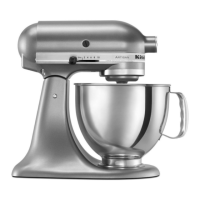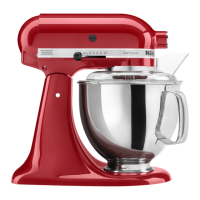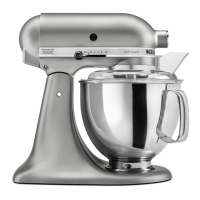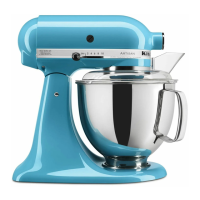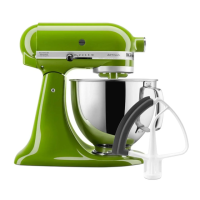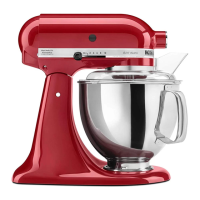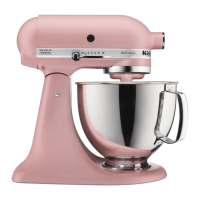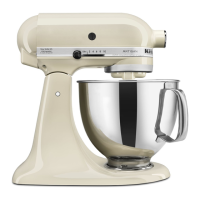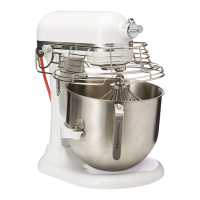Do you have a question about the KitchenAid KSM100 and is the answer not in the manual?
Guidelines for workspace cleanliness, technician attire, and personal safety during servicing.
Critical electrical precautions and key safeguards for safe mixer operation.
Mandatory ESD protection and power disconnection steps before performing any servicing.
Specifies voltage, frequency, plug usage, and adapter restrictions for the mixer.
Explains the electro-mechanical speed control system and its components.
Describes how the governor converts rotational speed into linear motion for speed control.
Methods for testing mixer performance, electrical components, and using a wattmeter.
Critical electrical shock hazard warning before servicing motor or speed control.
Testing stator coils for continuity to identify faults.
Adjusting screws to set STIR speed using finger touches or a tachometer.
Calibrating Speed 2, installing trim band/end cover, and performing final checks.
Adjusting beater-to-bowl clearance and troubleshooting issues.
Diagnosing bowl rocking from latch spring or bowl pin wear.
Troubleshooting steps for a mixer with no power, hum, or buzz.
Diagnosing issues when the motor operates but the planetary does not turn.
Troubleshooting mixers that hum but lack planetary rotation at high or low watts.
Troubleshooting lever position, bowl security, and beater clearance problems.
Addressing sparking at brushes and excessive noise from the mixer.
Steps to resolve issues where the speed control lever fails to shut off the mixer.
Diagnosing planetary movement, vibration, low power, and governor seating.
Identifying and resolving electrical shock hazards caused by bare wires or grounding issues.
Guidelines for workspace cleanliness, technician attire, and personal safety during servicing.
Critical electrical precautions and key safeguards for safe mixer operation.
Mandatory ESD protection and power disconnection steps before performing any servicing.
Specifies voltage, frequency, plug usage, and adapter restrictions for the mixer.
Explains the electro-mechanical speed control system and its components.
Describes how the governor converts rotational speed into linear motion for speed control.
Methods for testing mixer performance, electrical components, and using a wattmeter.
Critical electrical shock hazard warning before servicing motor or speed control.
Testing stator coils for continuity to identify faults.
Adjusting screws to set STIR speed using finger touches or a tachometer.
Calibrating Speed 2, installing trim band/end cover, and performing final checks.
Adjusting beater-to-bowl clearance and troubleshooting issues.
Diagnosing bowl rocking from latch spring or bowl pin wear.
Troubleshooting steps for a mixer with no power, hum, or buzz.
Diagnosing issues when the motor operates but the planetary does not turn.
Troubleshooting mixers that hum but lack planetary rotation at high or low watts.
Troubleshooting lever position, bowl security, and beater clearance problems.
Addressing sparking at brushes and excessive noise from the mixer.
Steps to resolve issues where the speed control lever fails to shut off the mixer.
Diagnosing planetary movement, vibration, low power, and governor seating.
Identifying and resolving electrical shock hazards caused by bare wires or grounding issues.
| Type | Stand Mixer |
|---|---|
| Model | KSM100 |
| Capacity | 4.5 quarts |
| Power | 275 Watts |
| Speed Settings | 10 |
| Bowl Material | Stainless Steel |
| Included Attachments | Flat Beater, Dough Hook, Wire Whip |
| Voltage | 120V |
| Color Options | Various |

